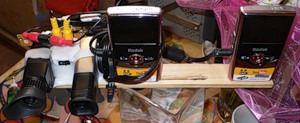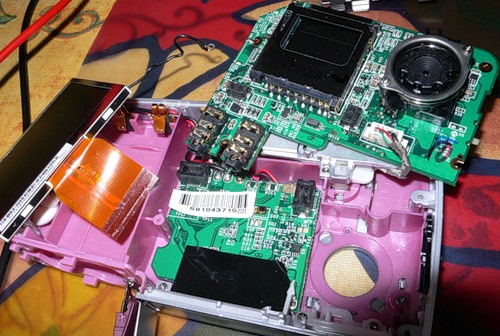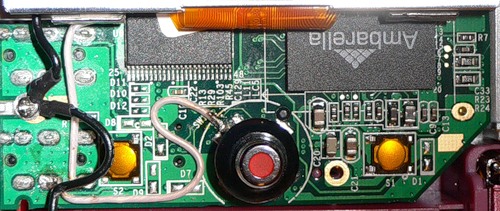DIY 3D Camera - SynchroStart!
 In the last series, I made myself a 3D viewfinder and looked at the world with an increased basis.
In the last series, I made myself a 3D viewfinder and looked at the world with an increased basis.But because of the lack of synchronization of the start of the cameras when shooting and playing at moving objects, the parallaxes dispersed not only horizontally (a jester with them) but also vertically! (and this is no harm to view)
By this, as it was planned, from Friday to Saturday I dedicated the synchronization of the cameras and the assembly of the entire farm into one set, so that it could just be taken, turned on and shot a 3D movie.
I did not understand zi6 for the first time and already knew that a joystick is waiting for me about six contacts, this simply pulls the camcorder's processor leads to the ground and the whole task, it seems, is reduced only to connecting these pins of both cameras.
At zi6, two four-pin mini jacks come out. One by one comes component HD, on the other composite video and stereo sound.

The capacitors through passage (C89, C91) between the connector and the chip are conveniently located on the edge of the board, which predetermined their fate to be dismantled, for the sake of a great goal. In addition to the start signal, I also decided to connect the battery packs of the cameras in order to power the viewfinder tubes from them through a step-up voltage converter.
Said done, the result on the photo.

Now the same procedure, you need to do with the second camera and then I was attacked by the paranoia of the hardware programmer, because the video processors each lived their own lives, and who knows how and how often, these buttons are polled there, so it’s not at all the fact that connecting them, I will launch the cameras synchronously, and maybe I still have to poke around with the oscilloscope in order to jam the clock generators of these processors.
But as practice has shown, these fears turned out to be in vain, at least, when viewing through the stereoscopic viewfinder, no artifacts of the rassinchron were noticed. The only glitch seen, from such a connection of two cameras, manifests itself at the moment when the cameras are turned on, when Ambarella loads and initializes the ports, it pulls them to the ground. If another camera is already turned on and loaded at this point, it will take it as a recording signal, while the newly loaded camera will stand. With subsequent clicks, the cameras synchronously swap places :-)
I assume that it is treated if a diode is inserted in each camera between the button and the connector, thus the cameras will no longer influence each other, and will only be started synchronously from an external button. But the cameras do not load in haste, and I quite manage to turn them on, and the start button still needs to be done, so for now, everything suits me.
I even collected everything on the same platform, although for now I still have wires tied to the power supply, and pity ...
But there is one more thing that grieves me, the mixing of the camera matrices.
I would not be a geek if, on the very first day, as soon as the cameras were brought to me, I didn’t pull off one of them, removing the cloudy protective glass covering the lens, and calibrating the Bayer interpolator for the matrix and lens features from the camera’s service menu, another camera, I I did not specifically touch to see the difference. And the difference was noticeable even on the lousy LCD displaycases! Inspired by the manufacture, calibration and testing of the stereoscopic viewfinder, I forgot about another camera. And although I removed the protective glass from it, the difference in calibration makes itself felt in such a way that it seems that they are not calibrated at all at the factory. Although the ambarella has a lot of interesting things in this regard, right up to the correction of the lens geometric distortions - but this is another story, shedding light on specialized processors for video cameras and cameras, their operating systems and software ...
I have the same time, on the agenda, autonomous power, calibration, and a script for converting video from two files into one but, YouTube stereo format.
If someone owns avisint, I would be very happy to see such a script in the comments ;-)
')
Ps. And what do you think, if the manufacturer publicly declares the technical characteristics of the product, which are clearly untrue and cannot even correspond to it for objective, physical reasons. What benefits can a consumer deceived by unfair advertising get from this? ;-)
Source: https://habr.com/ru/post/97273/
All Articles